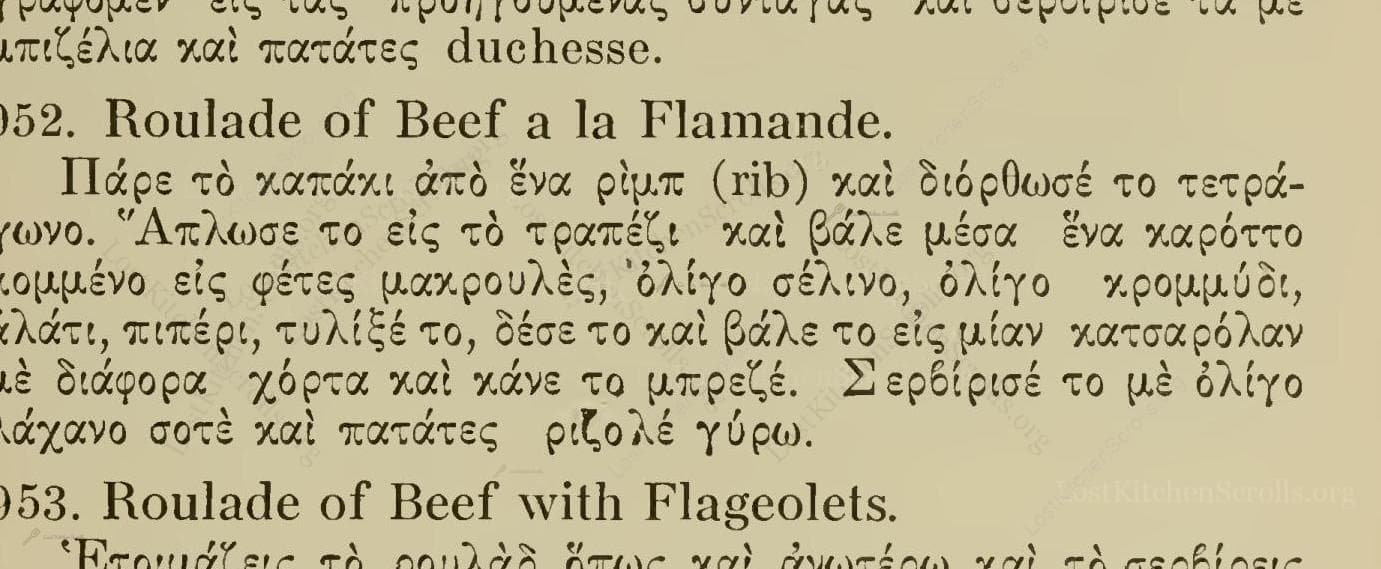Roulade Of Beef A La Flamande
"Roulade Of Beef À La Flamande"
From the treasured pages of Megale amerikanike mageirike dia mageirous kai oikogeneias
Written by Michael Gkines

Roulade Of Beef A La Flamande
"Πάρε τὸ καπάκι ἀπὸ ἕνα ρὶμπ (rib) καὶ διόρθωσέ το τετράγωνο. ῞Απλωσε το εἰς τὸ τραπέζι καὶ βάλε μέσα ἕνα καρόττο κομμένο εἰς φέτες μακρουλές, ὀλίγο σέλινο, ὀλίγο κρομμύδι, ἁλάτι, πιπέρι, τύλιξέ το, δέσε το καὶ βάλε το εἰς μίαν κατσαρόλαν μὲ διάφορα χόρτα καὶ κάνε το μπρεζέ. Σερβίρισέ το μὲ ὀλίγο λάχανο σοτὲ καὶ πατάτες ριζολὲ γύρω."
English Translation
"Take the cap from a rib and trim it into a square. Spread it on the table and put inside a carrot cut into long slices, a little celery, a little onion, salt, pepper; roll it up, tie it, and place it in a pot with various greens and braise it. Serve it with a little sautéed cabbage and potatoes rissolées around it."
Note on the Original Text
The original recipe uses a concise, to-the-point style, assuming the reader’s familiarity with core kitchen operations, like trimming, tying, and braising. Measurements are approximate or intuitive, as was customary, with directions based on observation rather than precise timing or temperatures. Greek spelling reflects early 20th-century usage, often employing phonetic transliterations for non-Greek ingredients or methods ('rib', 'brezé'). The simplicity is part of its practical charm and offers room for adaptation.

Title
Megale amerikanike mageirike dia mageirous kai oikogeneias (1917)
You can also click the book image above to peruse the original tome
Writer
Michael Gkines
Era
1917
Publisher
Ekdotika Katastemata
Background
A sumptuous journey through early 20th-century Greek-American kitchens, this cookbook offers practical and time-tested recipes for savory dishes and delightful sweets—each crafted to suit the American system, yet infused with Greek tradition. A perfect companion for both family cooks and aspiring chefs.
Kindly made available by
Internet Archive
This recipe hails from Michael Gkines' 1917 Greek-language cookbook 'Megale amerikanike mageirike', written for Greek immigrants in New York. It bridges traditional Greek home cooking with American ingredients and influences, reflecting a time of cultural adaptation in early 20th-century immigrant communities. The dish itself, 'Roulade de Boeuf à la Flamande', is inspired by French and Flemish braising techniques, but reinterpreted within the Greek culinary vocabulary and available local produce. The method blends practicality and hearty, familiar flavors, suitable for family feasts.

Back in 1917, cooks would have used a sturdy wooden table for rolling and tying the beef, a sharp kitchen knife for trimming and slicing, cotton twine for securing the roulade, and a large heavy-bottomed pot or enameled Dutch oven for braising over a wood or coal-fired stove. Vegetables would have been cut with a paring knife and sautéed or browned in a heavy iron or copper pan.
Prep Time
25 mins
Cook Time
2 hrs 30 mins
Servings
6
We've done our best to adapt this historical recipe for modern kitchens, but some details may still need refinement. We warmly welcome feedback from fellow cooks and culinary historians — your insights support the entire community!
Ingredients
- 2.2–3.3 lb beef rib cap (or beef brisket as a substitute)
- 1 large carrot (about 3.5 oz), peeled and sliced lengthwise
- 1 small celery stalk (about 2 oz), cut into strips
- 1 small onion (about 2.5 oz), thinly sliced
- Salt, to taste
- Black pepper, to taste
- Assorted fresh herbs and root vegetables (e.g., carrot, celery, parsley, leek) for braising
- 2 cups beef stock or water
- 1.1 lb green cabbage, sliced, for sautéing
- 1.1 lb potatoes, peeled and cut into cubes for frying
- 2–3 tablespoons olive oil or butter for sautéing
Instructions
- Take the cap (top) from a beef rib and trim it into a square shape, about 2.2 to 3.3 lb.
- Lay the beef flat on a clean table.
- Place inside a large carrot, peeled and sliced lengthwise, a small stalk of celery cut into strips, and a small onion, thinly sliced.
- Season generously with salt and pepper.
- Roll the beef tightly around the vegetables and tie it securely with kitchen twine.
- Place the roulade in a large pot or Dutch oven along with an assortment of aromatic herbs and vegetables (such as carrots, celery, onions, and leeks).
- Add enough broth or water to partially cover the beef, cover, and braise gently over low heat for 2–3 hours, until very tender.
- Serve sliced, with sautéed cabbage and golden pan-fried ('rissolée') potatoes arranged around the plate.
Estimated Calories
550 per serving
Cooking Estimates
You will spend about 25 minutes preparing your ingredients and rolling the beef. The beef then cooks gently for about 2.5 hours, while you can prepare the sautéed cabbage and potatoes towards the end. Each serving has about 550 calories, and this recipe makes 6 servings.
As noted above, we have made our best effort to translate and adapt this historical recipe for modern kitchens, taking into account ingredients nowadays, cooking techniques, measurements, and so on. However, historical recipes often contain assumptions that require interpretation.
We'd love for anyone to help improve these adaptations. Community contributions are highly welcome. If you have suggestions, corrections, or cooking tips based on your experience with this recipe, please share them below.
Join the Discussion
Rate This Recipe
Dietary Preference
Main Ingredients
Culinary Technique
Occasions

Den Bockfisch In Einer Fleisch Suppen Zu Kochen
This recipe hails from a German manuscript cookbook compiled in 1696, a time whe...

Die Grieß Nudlen Zumachen
This recipe comes from a rather mysterious manuscript cookbook, penned anonymous...

Ein Boudain
This recipe comes from an anonymous German-language manuscript cookbook from 169...

Ein Gesaltzen Citroni
This recipe, dating from 1696, comes from an extensive anonymous German cookbook...
Browse our complete collection of time-honored recipes



